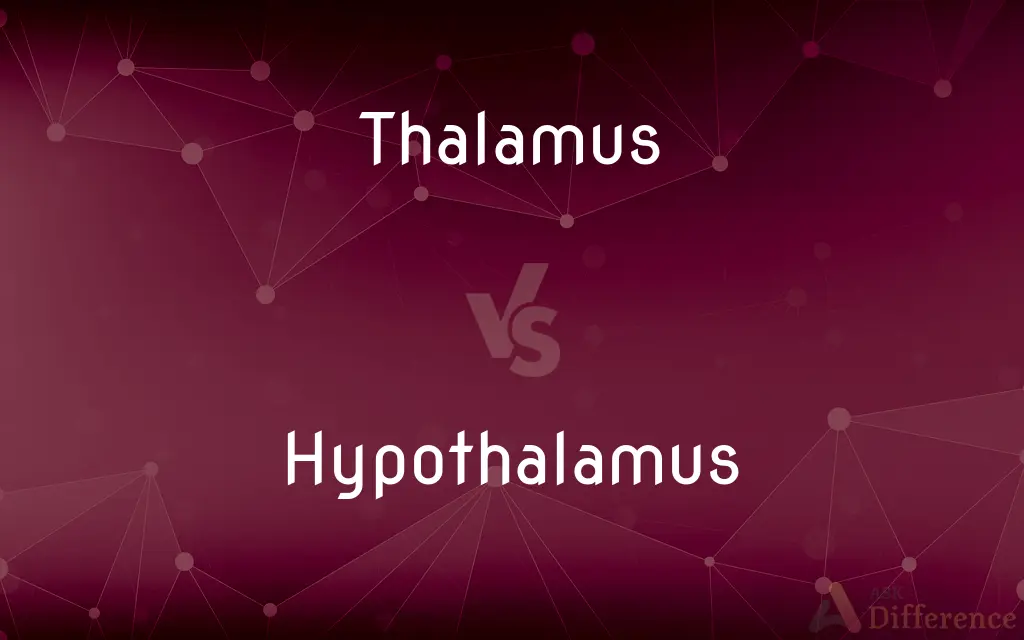Thalamus vs. Hypothalamus — What's the Difference?
By Tayyaba Rehman — Updated on October 13, 2023
The thalamus is a brain region involved in relaying sensory information, while the hypothalamus controls body temperature, hunger, thirst, and other vital functions.

Difference Between Thalamus and Hypothalamus
Table of Contents
ADVERTISEMENT
Key Differences
The thalamus and hypothalamus are both integral parts of the brain, serving distinct functions. The thalamus acts primarily as a relay station, transmitting sensory and motor signals to the cerebral cortex. It plays a pivotal role in processing information from our senses, such as sight and sound. The hypothalamus, conversely, is vital for maintaining the body's internal balance or homeostasis.
While the thalamus is associated with consciousness, sleep, and alertness due to its role in relaying sensory data, the hypothalamus is deeply involved in physiological processes. The hypothalamus regulates essential bodily functions like temperature, hunger, thirst, sleep-wake cycles, and the release of hormones. This difference in function is evident in how each structure interacts with other parts of the body and brain.
Anatomically, the thalamus is situated above the hypothalamus. It's a symmetrical structure, with two large lobes that reside on either side of the third ventricle. The hypothalamus, located below the thalamus, connects the nervous system to the endocrine system through the pituitary gland. Its position and connection indicate its central role in hormonal regulation.
To sum up, while both the thalamus and hypothalamus are essential for various brain functions, their primary roles differ significantly. The thalamus focuses on sensory data processing, and the hypothalamus emphasizes regulating and maintaining bodily functions and homeostasis.
Comparison Chart
Primary Function
Relays sensory and motor signals.
Regulates vital bodily functions and hormones.
ADVERTISEMENT
Anatomical Position
Above the hypothalamus.
Below the thalamus.
Association
Consciousness, sleep, alertness.
Homeostasis, hunger, thirst, body temperature.
Interaction
Connects to the cerebral cortex.
Connects the nervous system to the endocrine via the pituitary gland.
Size
Larger, with two lobes.
Smaller compared to thalamus.
Compare with Definitions
Thalamus
Located above the hypothalamus.
In the brain's anatomy, the thalamus sits atop the hypothalamus.
Hypothalamus
Crucial for maintaining homeostasis.
The body's internal balance is overseen by the hypothalamus.
Thalamus
Consists of two large lobes.
The bilateral nature of the thalamus makes it a symmetrical structure.
Hypothalamus
Plays a role in sleep-wake cycles.
Irregular sleep patterns might indicate a hypothalamus issue.
Thalamus
Central hub for transmitting signals to the cerebral cortex.
The thalamus acts as a gateway to the cortex.
Hypothalamus
Connects the nervous system to the endocrine system.
Through the pituitary gland, the hypothalamus influences hormone release.
Thalamus
Involved in consciousness and alertness.
The thalamus plays a part in our sleep-wake cycle.
Hypothalamus
A brain region that regulates vital functions like temperature and hunger.
The hypothalamus keeps the body's temperature in check.
Thalamus
A brain structure that relays sensory information.
The thalamus processes the sound before it reaches the auditory cortex.
Hypothalamus
Located below the thalamus.
Anatomically, the hypothalamus is positioned beneath the thalamus.
Thalamus
The thalamus (from Greek θάλαμος, "chamber") is a large mass of gray matter located in the dorsal part of the diencephalon (a division of the forebrain). Nerve fibers project out of the thalamus to the cerebral cortex in all directions, allowing hub-like exchanges of information.
Hypothalamus
The hypothalamus (from Ancient Greek ὑπό, "under", and θάλαμος, "chamber") is a portion of the brain that contains a number of small nuclei with a variety of functions. One of the most important functions of the hypothalamus is to link the nervous system to the endocrine system via the pituitary gland.
Thalamus
A large ovoid mass of gray matter situated in the posterior part of the forebrain that relays sensory impulses to the cerebral cortex.
Hypothalamus
The part of the brain that lies below the thalamus, forming the major portion of the ventral region of the diencephalon and functioning to regulate bodily temperature, certain metabolic processes, and other autonomic activities.
Thalamus
(neuroanatomy) Either of two large, ovoid structures of grey matter within the forebrain that relay sensory impulses to the cerebral cortex.
Hypothalamus
(anatomy) A region of the forebrain located below the thalamus, forming the basal portion of the diencephalon, and functioning to regulate body temperature, some metabolic processes and governing the autonomic nervous system.
Thalamus
(botany) The receptacle of a flower; a torus.
Hypothalamus
A basal part of the diencephalon governing autonomic nervous system
Thalamus
A thallus.
Thalamus
An inner room or nuptial chamber.
Thalamus
A mass of nervous matter on either side of the third ventricle of the brain; - called also optic thalamus.
Thalamus
Same as Thallus.
Thalamus
Large egg-shaped structures of gray matter that form the dorsal subdivision of the diencephalon
Common Curiosities
Are the thalamus and hypothalamus part of the limbic system?
Yes, both are part of the limbic system, which deals with emotions and memories.
What's the primary function of the thalamus?
The thalamus relays sensory and motor signals to the cerebral cortex.
Does the thalamus play a role in our senses?
Yes, the thalamus processes and relays sensory information to the cerebral cortex.
Where is the hypothalamus located in relation to the thalamus?
The hypothalamus is located below the thalamus.
How does the thalamus impact consciousness?
The thalamus is associated with consciousness, sleep, and alertness due to its role in relaying sensory data.
How does the hypothalamus contribute to hormone regulation?
The hypothalamus connects the nervous system to the endocrine system through the pituitary gland, influencing hormone release.
How does the thalamus interact with the rest of the brain?
The thalamus connects and relays information to the cerebral cortex, facilitating communication between different brain regions.
Does the hypothalamus play a role in emotions?
Yes, the hypothalamus is involved in emotional responses and behavior.
How does the hypothalamus help in responding to stress?
The hypothalamus releases stress hormones and is involved in the "fight or flight" response.
What happens when there's a malfunction in the thalamus?
Malfunctions in the thalamus can lead to issues in sensory perception, sleep disturbances, and other neurological problems.
Can injuries to the thalamus impact sensory perception?
Yes, damage to the thalamus can affect sensory processing and perception.
What does the hypothalamus regulate in terms of bodily functions?
The hypothalamus regulates body temperature, hunger, thirst, sleep-wake cycles, and more.
Is the thalamus larger than the hypothalamus?
Yes, the thalamus is larger and consists of two lobes.
Can disorders of the hypothalamus lead to weight gain or loss?
Yes, since the hypothalamus regulates hunger and thirst, disorders can influence appetite and lead to weight changes.
Is the hypothalamus involved in the body's circadian rhythm?
Yes, the hypothalamus plays a crucial role in regulating the body's internal clock or circadian rhythm.
Share Your Discovery

Previous Comparison
Backgammon vs. Tricktrack
Next Comparison
Cast vs. MoldAuthor Spotlight
Written by
Tayyaba RehmanTayyaba Rehman is a distinguished writer, currently serving as a primary contributor to askdifference.com. As a researcher in semantics and etymology, Tayyaba's passion for the complexity of languages and their distinctions has found a perfect home on the platform. Tayyaba delves into the intricacies of language, distinguishing between commonly confused words and phrases, thereby providing clarity for readers worldwide.














































